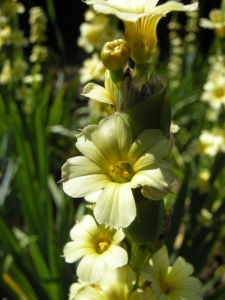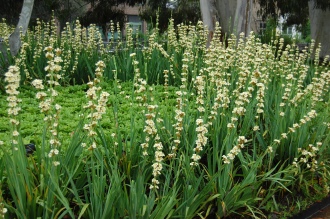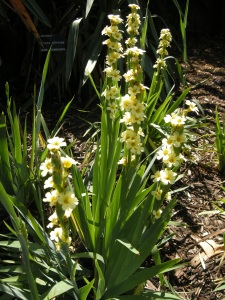Position: Full sun to partial shade
Soil: Moist, well drained
Flowering period: Early to mid summer
Eventual Height: 90cm
Eventual Spread: 25cm
Hardiness: 7a, 7b, 8a, 8b, 9a, 9b, 10a, 10b
Family: Iridaceae
Sisyrinchium striatum is an evergreen perennial with a clump forming habit. Its foliage is linear to lance shaped and iris-like but double ranked, stiff and greyish green. In early and mid summer unbranched stems bear stalk less clusters of open, cup shaped, pale yellow flowers with tepal backs striped purple-brown.
Sisyrinchium striatum, commonly known as Pale Yellow Eyed Grass or Sisyrinchium, is native to Chile and Argentina. In its native habitat it grows in alpine grasslands and open woods.
The etymological root of the binomial name Sisyrinchium was derived from the Greek sys ‘pig’ and rynchos ‘snout’, referring to the roots being consumed by swine. Striatum is derived from the Latin striatus meaning ‘channeled’ or ‘grooved’.
The Landscape architect may find Sisyrinchium striatum useful as a low ground cover. Once established this plant is drought tolerant.
Sisyrinchium striatum will tolerate many different soil conditions; it will be happy in neutral or alkaline pH levels, in loam, sand or chalk in a sheltered or exposed location but will prefer a south facing aspect.
Ecologically, Sisyrinchium striatum will attract many pollinating insects such as honey bees.
The Royal Horticultural Society have given the cultivar Sisyrinchium striatum ‘Aunt May’, with its foliage being a beautiful sword-grey and variegated with stripes of creamy white banding at the edges, their prestigious Award of Garden Merit.
Sisyrinchium striatum requires little maintenance required. Large clumps may be divided in spring. Discoloured foliage and faded flowers may be removed at any time.







This plant puts out gilions of small plants from the seeds that take over a yard!